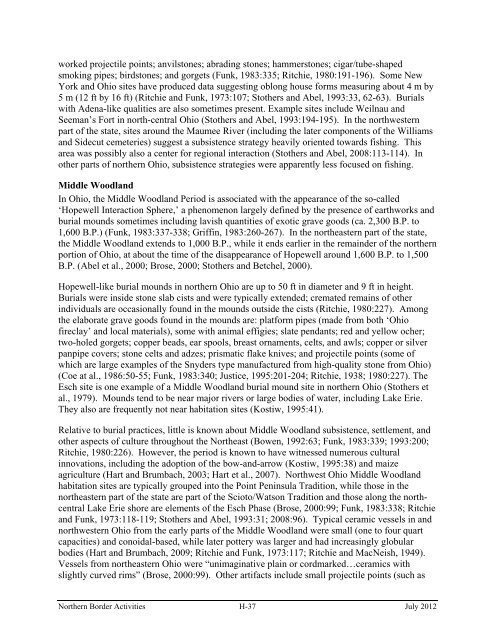Appendix H - Historical Archaeological and ... - CBP.gov
Appendix H - Historical Archaeological and ... - CBP.gov
Appendix H - Historical Archaeological and ... - CBP.gov
You also want an ePaper? Increase the reach of your titles
YUMPU automatically turns print PDFs into web optimized ePapers that Google loves.
worked projectile points; anvilstones; abrading stones; hammerstones; cigar/tube-shaped<br />
smoking pipes; birdstones; <strong>and</strong> gorgets (Funk, 1983:335; Ritchie, 1980:191-196). Some New<br />
York <strong>and</strong> Ohio sites have produced data suggesting oblong house forms measuring about 4 m by<br />
5 m (12 ft by 16 ft) (Ritchie <strong>and</strong> Funk, 1973:107; Stothers <strong>and</strong> Abel, 1993:33, 62-63). Burials<br />
with Adena-like qualities are also sometimes present. Example sites include Weilnau <strong>and</strong><br />
Seeman’s Fort in north-central Ohio (Stothers <strong>and</strong> Abel, 1993:194-195). In the northwestern<br />
part of the state, sites around the Maumee River (including the later components of the Williams<br />
<strong>and</strong> Sidecut cemeteries) suggest a subsistence strategy heavily oriented towards fishing. This<br />
area was possibly also a center for regional interaction (Stothers <strong>and</strong> Abel, 2008:113-114). In<br />
other parts of northern Ohio, subsistence strategies were apparently less focused on fishing.<br />
Middle Woodl<strong>and</strong><br />
In Ohio, the Middle Woodl<strong>and</strong> Period is associated with the appearance of the so-called<br />
‘Hopewell Interaction Sphere,’ a phenomenon largely defined by the presence of earthworks <strong>and</strong><br />
burial mounds sometimes including lavish quantities of exotic grave goods (ca. 2,300 B.P. to<br />
1,600 B.P.) (Funk, 1983:337-338; Griffin, 1983:260-267). In the northeastern part of the state,<br />
the Middle Woodl<strong>and</strong> extends to 1,000 B.P., while it ends earlier in the remainder of the northern<br />
portion of Ohio, at about the time of the disappearance of Hopewell around 1,600 B.P. to 1,500<br />
B.P. (Abel et al., 2000; Brose, 2000; Stothers <strong>and</strong> Betchel, 2000).<br />
Hopewell-like burial mounds in northern Ohio are up to 50 ft in diameter <strong>and</strong> 9 ft in height.<br />
Burials were inside stone slab cists <strong>and</strong> were typically extended; cremated remains of other<br />
individuals are occasionally found in the mounds outside the cists (Ritchie, 1980:227). Among<br />
the elaborate grave goods found in the mounds are: platform pipes (made from both ‘Ohio<br />
fireclay’ <strong>and</strong> local materials), some with animal effigies; slate pendants; red <strong>and</strong> yellow ocher;<br />
two-holed gorgets; copper beads, ear spools, breast ornaments, celts, <strong>and</strong> awls; copper or silver<br />
panpipe covers; stone celts <strong>and</strong> adzes; prismatic flake knives; <strong>and</strong> projectile points (some of<br />
which are large examples of the Snyders type manufactured from high-quality stone from Ohio)<br />
(Coe at al., 1986:50-55; Funk, 1983:340; Justice, 1995:201-204; Ritchie, 1938; 1980:227). The<br />
Esch site is one example of a Middle Woodl<strong>and</strong> burial mound site in northern Ohio (Stothers et<br />
al., 1979). Mounds tend to be near major rivers or large bodies of water, including Lake Erie.<br />
They also are frequently not near habitation sites (Kostiw, 1995:41).<br />
Relative to burial practices, little is known about Middle Woodl<strong>and</strong> subsistence, settlement, <strong>and</strong><br />
other aspects of culture throughout the Northeast (Bowen, 1992:63; Funk, 1983:339; 1993:200;<br />
Ritchie, 1980:226). However, the period is known to have witnessed numerous cultural<br />
innovations, including the adoption of the bow-<strong>and</strong>-arrow (Kostiw, 1995:38) <strong>and</strong> maize<br />
agriculture (Hart <strong>and</strong> Brumbach, 2003; Hart et al., 2007). Northwest Ohio Middle Woodl<strong>and</strong><br />
habitation sites are typically grouped into the Point Peninsula Tradition, while those in the<br />
northeastern part of the state are part of the Scioto/Watson Tradition <strong>and</strong> those along the northcentral<br />
Lake Erie shore are elements of the Esch Phase (Brose, 2000:99; Funk, 1983:338; Ritchie<br />
<strong>and</strong> Funk, 1973:118-119; Stothers <strong>and</strong> Abel, 1993:31; 2008:96). Typical ceramic vessels in <strong>and</strong><br />
northwestern Ohio from the early parts of the Middle Woodl<strong>and</strong> were small (one to four quart<br />
capacities) <strong>and</strong> conoidal-based, while later pottery was larger <strong>and</strong> had increasingly globular<br />
bodies (Hart <strong>and</strong> Brumbach, 2009; Ritchie <strong>and</strong> Funk, 1973:117; Ritchie <strong>and</strong> MacNeish, 1949).<br />
Vessels from northeastern Ohio were “unimaginative plain or cordmarked…ceramics with<br />
slightly curved rims” (Brose, 2000:99). Other artifacts include small projectile points (such as<br />
Northern Border Activities H-37 July 2012
















